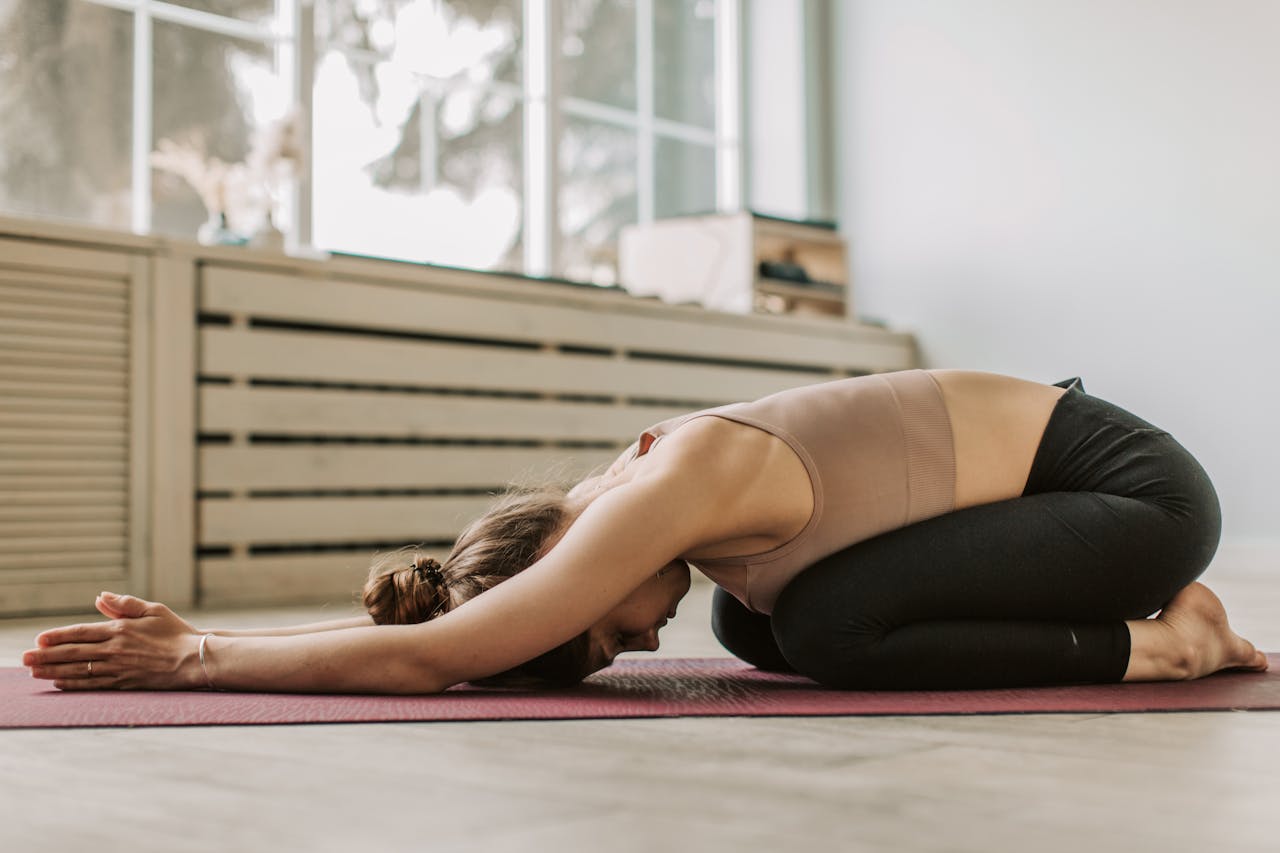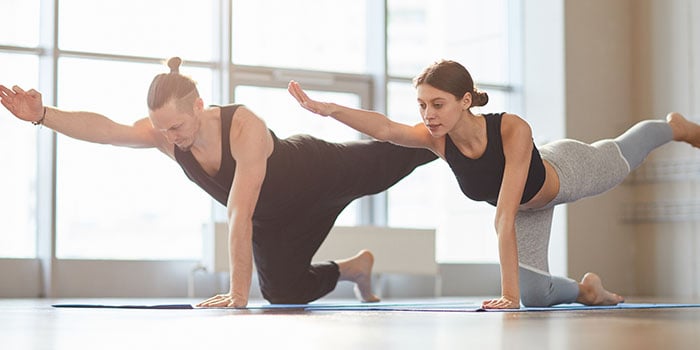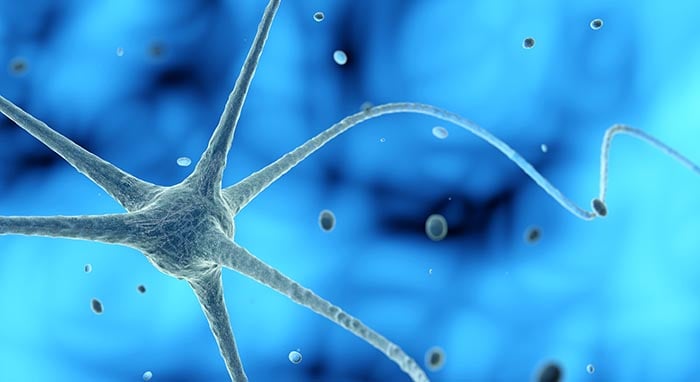
Table of Contents
Are you suffering from irritated nerves, causing pain in your shoulders and back? If so, you should try gentle yoga and their so-called nerve flossing practice. This practice relieves pain with movements called nerve glides.
We can use nerve flossing to help relieve pain from compressed or irritated nerves. It includes simple exercises that you can practice at home. These exercises gently stretch and mobilize muscles that may cause nerve compression or irritation, providing relief from pain. They can also help increase flexibility and range of motion.
Nerve flossing can be combined with gentle, relaxed stretching exercises to relieve nerve pain and discomfort further.
What is Nerve Flossing?

Nerve flossing can help with neck, shoulder, and upper back pain. It can also help with sciatica and piriformis syndrome.
When doing nerve flossing exercises, the goal is to relax stretched muscles. Deep breathing can help in staying relaxed.
A key point about nerve gliding exercises is to do them slowly. You should not experience pain when doing these gentle exercises.
Why Staying Relaxed is Helpful
One reason you may need nerve flossing exercises is excessive tension. This may be because you are stressed and thus in fight or flight mode. And so, an essential element of nerve flossing is to relax so that you help trigger your parasympathetic nervous system.
With the parasympathetic nervous system activated, you may find that it becomes easier to relax the tense muscles that cause nerve irritation or pinching. So that it is easier for you to stay relaxed, you may also find doing yoga classes in addition to nerve flossing helps.
Areas Where Nerve Glide Could Be Helpful
Nerve flossing exercises target specific nerves. These include the following:
-
Cervical nerve, pain radiating into the shoulder or arm
-
The median nerve, nerve pain associated with carpal tunnel syndrome
-
The sciatic nerve, pain along the back of the thigh, calf, or foot
-
Femoral nerve, pain or weakness at the front of the thigh, difficulty in going upstairs
-
Sural nerve, pain along the outer foot and fifth toe
-
Peroneal nerve, pain, or weakness along the top of the foot
-
Tibial nerve, tingling, or weakness along the bottom of the foot
Piriformis syndrome is where the piriformis muscle compresses the sciatic nerve causing buttock pain, sciatic nerve pain, or both.
Examples of Nerve Flossing Exercises
Following are some simple targeted nerve flossing exercises and stretches. Always speak with your doctor before doing any type of exercise.

Cervical Nerve Glide
The cervical nerve glide is good to use if you have stiffness in the neck and upper back — a common occurrence if you sit at a desk all day.
To do this nerve flossing exercise, sit in a chair with your back straight. Position your feet flat on the floor in front of you. Take your right hand and place it behind your lower back. Relax your arms and neck on both sides but maintain a good posture.
Take your left hand and place it on your head and slightly over on the right side. Very slowly and gently, pull your head down and to the left until you feel a stretch on the right side of your neck, then stop. You should feel a stretch from the base of your skull to your shoulder and upper back. Hold for a few counts, release, and repeat a few times. Then switch sides.
Tendon Stretching for Carpal Tunnel Syndrome
There are a few tendon stretching exercises for carpal tunnel syndrome. Following are two pairs of stretches, with each pair including complementary stretches.
One exercise for stretching the wrist tendons has a starting position with the elbow bent. Bend the wrist back and straighten your fingers. Reach the thumb out to the side. Slowly straighten your elbow forwards to end up with your hand in a “stop” position.
Slowly relax and repeat three to five times for each arm.
The compliment to this exercise is to bend the wrist forwards. Straighten the fingers. Reach the thumb straight out to the side. Slowly straighten the elbow forwards.
Slowly relax and repeat three to five times for each arm.
The following exercises are done with the fingers curled into a fist.
First, make a fist with the thumb wrapped in front of your fingers with one hand. Bend your wrist up. Then slowly straighten your elbow forwards. Pause, and then release. Repeat three times for each arm.
The compliment to the above action is again to make a fist but bend your wrist forwards. Straighten your elbow forwards. Pause and then slowly release. Repeat three times for each arm.
Seated Sciatic Nerve Flossing
For this seated sciatic nerve floss, sit in a chair in a slumped position with your pelvis tilted back so that your lumbar spine flattens. Drop your chest and bend your head forwards. Have your feet flat on the floor with one foot slightly forwards. Slowly straighten the knee of the forward foot. From there, bend your toes towards you. Pause, and then slowly release.
Repeat 5 to 10 times per side.
A variation involves working towards the coordinated movement of your leg and head.
To begin, sit upright. Straighten one knee and bend your toes back. Then slowly bend your neck back and look up. Pause for a slow breath or two, slowly lower your leg and tilt your head forward simultaneously.
Practice lifting your leg first and then looking up second. Then, once you are comfortable with both actions, you can optionally work towards doing both actions simultaneously.
Femoral Nerve Glide
For this prone femoral nerve glide, lay on your stomach on a yoga mat. Bend your elbows. Place your arms up near your head, relaxing your forehead on your hands.
This exercise will involve moving the head and one leg.
Bend one of your legs up toward your buttocks, keeping your thigh on the mat. Moving slowly, stop the movement just before the onset of pain or discomfort.
As you lower your leg, lift your head.
Now, lower your head as you lift one leg. Lift your head as you lower the leg.
Repeat several times, taking care to move slowly and carefully. Then, switch to the other leg.
Benefits and Things to Think About
When performing Nerve flossing, it mustn't be painful. If you experience pain, stop right away.
You should ensure that before you start and during the exercise, your muscles throughout the body are as relaxed as possible, avoiding causing additional discomfort or injury.
Do long, deep breaths, inhale through your nose, and exhale through your mouth.
Make sure you start slowly and adjust to your own pace and ability. Only perform a few repetitions to begin with, and once you feel more comfortable, you can increase the intensity.
Nerve Flossing Exercises Benefits
-
Pain relief
-
Reduces muscle tension
-
Improved mobility
-
Reducing inflamed nerves
Nerve Flossing Frequently Asked Questions
What is Nerve Flossing?
It is a type of exercise with gentle movements to stretch irritated nerves to reduce pain and improve the range of motion. It is also known as nerve gliding or neural gliding.
How Often Should Nerve Flossing be Done?
You should try and do it several times each day, depending on the issues you are experiencing. If you are suffering from painful sciatica, perform a leg exercise for one leg at a time, perform several reps and do so a couple of times a day.
How Long Does it Take Before Nerve Flossing Treatment Start Showing Results?
It is individual from person to person and what type of issues you are suffering. But you should experience less or reduced pain within a few weeks from starting the exercises.
References
Nerve flossing: What it is, purpose, and exercises
Neuroanatomy, Somatic Nervous System - StatPearls - NCBI Bookshelf
A New Type of Median Nerve Glide for Carpal Tunnel Syndrome | Hand Therapy Academy
Disclaimer
The contents of this article are provided for informational purposes only and are not intended to substitute for professional medical advice, diagnosis, or treatment. It is always recommended to consult with a qualified healthcare provider before making any health-related changes or if you have any questions or concerns about your health. Anahana is not liable for any errors, omissions, or consequences that may occur from using the information provided.

Dr. Darlene Buan-Basit is a highly experienced licensed Chiropractor and Pilates instructor with expertise in many techniques, including Medical Acupuncture, Traditional Chinese Medicine, and Advanced Massage Techniques.